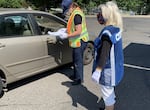In the looped parking lot of the Ashland Middle School, Katie Gibble greets cars as they slowly drive up to an easy-up tent and stacks of cardboard boxes, each containing a home air purifier.
“Are you here to pick up?” Gibble asks the drivers.
One by one, she consults a clipboard and, along with several volunteers, loads a purifier into each car.

Katie Gibble of Ashland Fire and Rescue consults a list of recipients of free home air purifiers during a giveaway program in Ashland.
Erik Neumann / Jefferson Public Radio
“You want to set it right there? OK, perfect. If you pull up a little bit more they’ll load it in for you,” she says.
The air filter giveaway is part of the Smokewise Ashland program. The city is giving out 500 home air purifiers with the help of an $85,000 smoke mitigation grant. It targets people with financial need and those whose age and health conditions make them especially vulnerable to smoke exposure.
The program — and fire season — comes at a time when many are already trying to protect themselves from a dual respiratory threat in the coronavirus.
Related: A User's Guide To Masks: What's Best At Protecting Others (And Yourself)
Chris Chambers helped organize the filter giveaway with Ashland Fire and Rescue. He says purifiers like these are critical for creating smoke-free areas at home.
“When you get to the point of multiple days of smoke, there’s no opening the windows and letting the fresh air come in because its smoke. Every. Single. Day,” he says.
By many accounts, 2020 could be a bad year for smoke. The fire season was officially declared a month early in Oregon. And forecasts point to dry long-term conditions.
The pandemic has added complications. Group firefighting camps will make it hard to practice social distancing. And the virus makes it risky for firefighters to travel to help put out big fires. Still, officials say the public shouldn’t see a big difference in wildfire response.
“We always try to put fires out as quickly as we can and as safely as we can,” says Jessica Gardetto with the National Interagency Fire Center in Boise. “However, smoke will be an issue, especially for people who are sensitive to it and who may have COVID.
Many of the same people who are at high risk for COVID-19 are also at elevated risk for smoke exposure — seniors, pregnant women, and people with pre-existing health conditions.
“We haven’t yet experienced a bad wildfire season in the midst of the COVID-19 pandemic. But I’m concerned,” says John Balmes, a professor of medicine at UC San Francisco.
Balmes worries about a major wildfire incident like the 2018 Camp Fire that blanketed huge parts of California in smoke.
“I think that will potentially increase the risk of SARS CoV-2 infection and also increase the risk of progression from asymptomatic infection to more symptomatic infection which is called COVID-19,” he says.
Just months into the pandemic, there is emerging research about the effects of air pollution on people with COVID-19. A nationwide study from the Harvard School of Public Health released in April found that living with high levels of fine particulate pollution is associated with an 8% increase in the COVID-19 death rate.
Balmes says those concerns about general air pollution also apply to wildfire smoke.
“The data that we have already are pretty suggestive that there’s an air pollution effect and wildfire smoke is a source of fine particulate and gases that have been associated with other viral infections,” he says. “So, the evidence is pretty strong, actually.”
If there’s any upside to the double respiratory threat, it may be that safety precautions for COVID-19 and wildfire smoke overlap.
Wearing a mask is one. Balmes says many of the masks being worn to prevent COVID-19 exposure help some for wildfire smoke, but N95 masks are the most effective at keeping out the fine particulate matter in smoke.
“Air pollution is one of those things where the more you look at it the worse it gets,” says Sarah Coefield. She works with the air quality program at Missoula Public Health in a part of Montana where wildfire smoke is a regular part of life.
Coefield says the best thing people can do to prepare for wildfire smoke is to create their own clean indoor air space where they can shelter at home.
“That’s really your best bet is to have a place with safer air to breathe. And you don’t get that unless you actually make it,” she says.
That means upgrading the filter in your home air handler or buying a portable air cleaner like the ones being given out at Ashland Middle School.
“This morning it looks like we’re going to give away about 60, 65,” Chambers says, after several hours.
Programs like Smokewise Ashland are rare in fire-prone communities, he says.
A warming climate with more smoke and complicating factors like the coronavirus pandemic are just a few reasons other communities might also consider them.
“This kind of thing is going to be more needed and I think more common throughout the West,” he says.